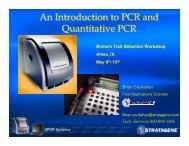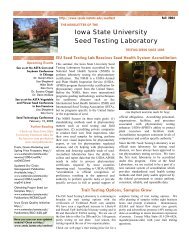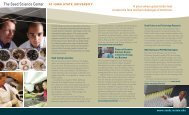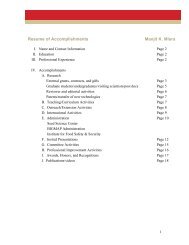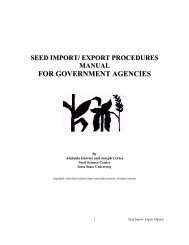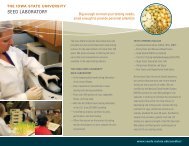Confined Production Processes for Non-Food Corn - Seed Science ...
Confined Production Processes for Non-Food Corn - Seed Science ...
Confined Production Processes for Non-Food Corn - Seed Science ...
You also want an ePaper? Increase the reach of your titles
YUMPU automatically turns print PDFs into web optimized ePapers that Google loves.
Summary: ProcessDescriptionsThe general philosophy <strong>for</strong> compliant confinementsystems is <strong>for</strong> planning the overall system and individualprocesses to comprise a logical flow of redundant tasksthat can be clearly managed and tracked. The confinementmanagement activities are described here as a hierarchyof procedures, subprocedures, activities, and subactivitiesnecessary to achieve corn confinement consistent withcurrent regulatory standards (that is “good practice”standards). These management activities are describedhere as generalized “activity group descriptions” andare more explicitly detailed in the corresponding flowdiagrams. The approach represented in these descriptionsis one where <strong>for</strong> each subprocess (<strong>for</strong> example, fieldproduction management represents a subprocess <strong>for</strong> fieldproduction) or activity grouping (<strong>for</strong> example, preplantingrepresents an activity grouping under the field productionmanagement operation), there are nests of subactivitiesdescribed entailing(i)development or confirmation of appropriate protocols,standard operating procedures (SOPs), and training;(ii) execution of management activities compliant withthe protocols, standards, and training; and(iii) quality control or quality assurance (QC/QA) actionsto confirm and document compliance with protocols,standards, and training.Effective management of confinement operationswill be most impacted by human failures in planning,implementation, and follow-up. These process descriptionsand the corresponding flow diagrams are intended as aresource <strong>for</strong> minimizing system error rates. These “goodpractices” are meant to exemplify only one of manyalternative management schemes that can meet regulatoryexpectations <strong>for</strong> confinement.PROCESS DESCRIPTION OUTLINEI. PLANT TRANSFORMATION AND GREENHOUSEA. Planning Stage• Assign staff with appropriate training andexperience in construction of cloning vector• Develop QA/QC plan <strong>for</strong> trans<strong>for</strong>mation vector• Prepare detailed vector development plan• Achieve appropriate resource planning, includingthe intellectual property issues associatedwith vector• Achieve necessary regulator approval, if required• Check identity of vectorB. Plant Trans<strong>for</strong>mation• Assign trained personal <strong>for</strong> trans<strong>for</strong>mation• Prepare trans<strong>for</strong>mation plan (Agrobacterium vs.biolistic trans<strong>for</strong>mation method)• Develop SOP <strong>for</strong> trans<strong>for</strong>mation• Implement trans<strong>for</strong>mation SOP <strong>for</strong>trans<strong>for</strong>mation process• Implement aseptic techniques• Label individual trans<strong>for</strong>mation plates withvector identification• Document trans<strong>for</strong>mation procedure and resultsC. Selection of Trans<strong>for</strong>mant and Regeneration• Use trained personnel• Develop SOP <strong>for</strong> selection and regenerationof trans<strong>for</strong>mant• Implement aseptic strategy during the process• Identify individual trans<strong>for</strong>mants properly• Select stable trans<strong>for</strong>mant• Regenerate trans<strong>for</strong>mant• Collect quality in<strong>for</strong>mation



